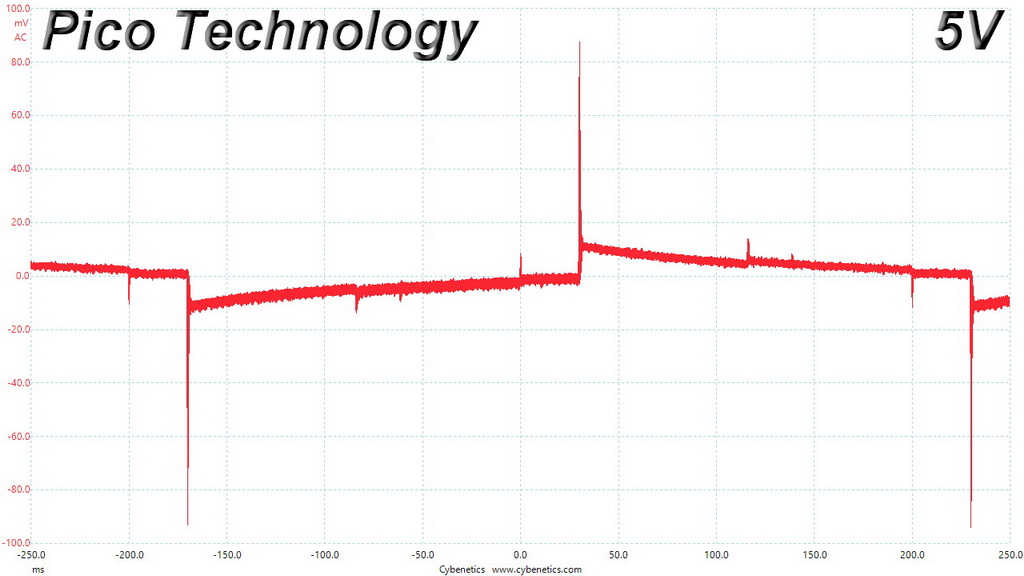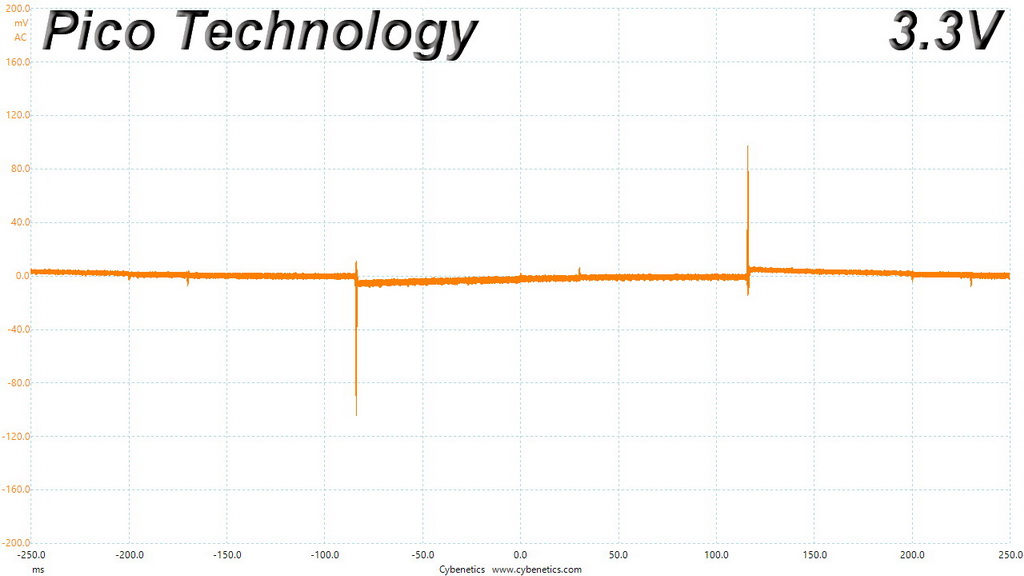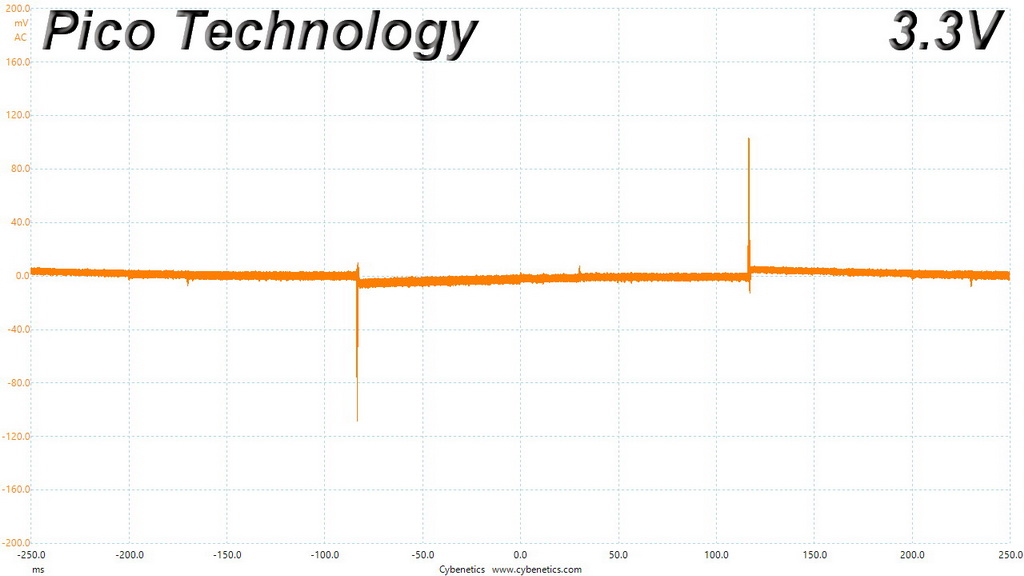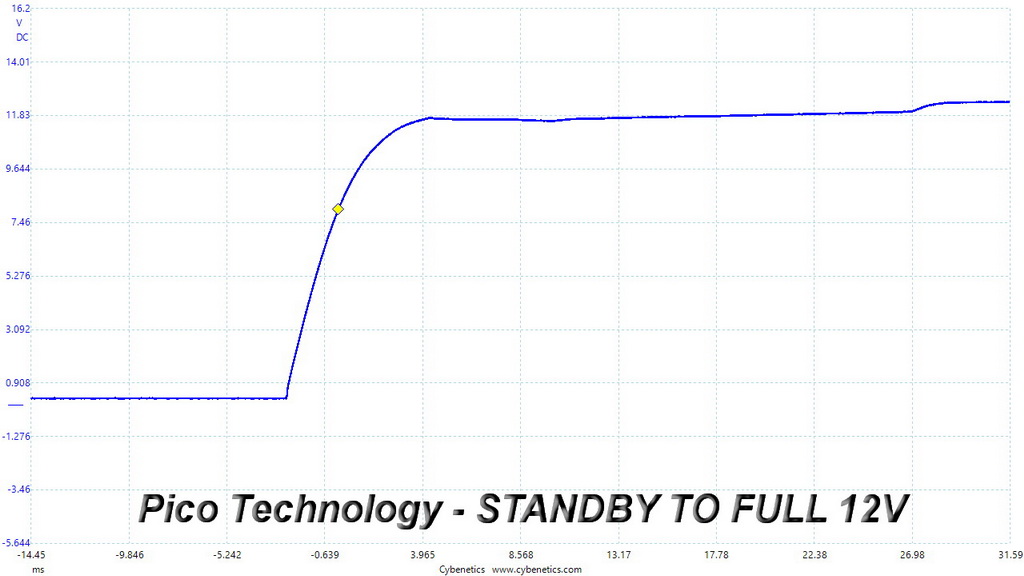Corsair RM850x White PSU Review
Why you can trust Tom's Hardware
Transient Response Tests
Advanced Transient Response Tests
For details on our transient response testing, please click here.
Ιn these tests, we monitor the RM850x's response in several scenarios. First, a transient load (10A at +12V, 5A at 5V, 5A at 3.3V, and 0.5A at 5VSB) is applied for 200ms as the PSU works at 20 percent load. In the second scenario, it's hit by the same transient load while operating at 50 percent load.
In the next sets of tests, we increase the transient load on the major rails with a new configuration: 15A at +12V, 6A at 5V, 6A at 3.3V, and 0.5A at 5VSB. We also increase the load-changing repetition rate from 5 Hz (200ms) to 50 Hz (20ms). Again, this runs with the PSU operating at 20 and 50 percent load.
The last tests are even tougher. Although we keep the same loads, the load-changing repetition rate rises to 1 kHz (1ms).
In all of the tests, we use an oscilloscope to measure the voltage drops caused by the transient load. The voltages should remain within the ATX specification's regulation limits.
These tests are crucial because they simulate the transient loads a PSU is likely to handle (such as booting a RAID array or an instant 100 percent load of CPU/GPUs). We call these "Advanced Transient Response Tests," and they are designed to be very tough to master, especially for a PSU with a capacity of less than 500W.
Advanced Transient Response at 20 Percent – 200ms
| Voltage | Before | After | Change | Pass/Fail |
|---|---|---|---|---|
| 12V | 12.111V | 12.051V | 0.50% | Pass |
| 5V | 5.036V | 4.941V | 1.89% | Pass |
| 3.3V | 3.321V | 3.217V | 3.13% | Pass |
| 5VSB | 5.013V | 4.970V | 0.86% | Pass |
Advanced Transient Response at 20 Percent – 20ms
| Voltage | Before | After | Change | Pass/Fail |
|---|---|---|---|---|
| 12V | 12.112V | 12.030V | 0.68% | Pass |
| 5V | 5.037V | 4.934V | 2.04% | Pass |
| 3.3V | 3.322V | 3.199V | 3.70% | Pass |
| 5VSB | 5.013V | 4.965V | 0.96% | Pass |
Advanced Transient Response at 20 Percent – 1ms
| Voltage | Before | After | Change | Pass/Fail |
|---|---|---|---|---|
| 12V | 12.113V | 12.033V | 0.66% | Pass |
| 5V | 5.037V | 4.930V | 2.12% | Pass |
| 3.3V | 3.322V | 3.200V | 3.67% | Pass |
| 5VSB | 5.014V | 4.964V | 1.00% | Pass |
Advanced Transient Response at 50 Percent – 200ms
| Voltage | Before | After | Change | Pass/Fail |
|---|---|---|---|---|
| 12V | 12.090V | 12.034V | 0.46% | Pass |
| 5V | 5.033V | 4.933V | 1.99% | Pass |
| 3.3V | 3.316V | 3.205V | 3.35% | Pass |
| 5VSB | 5.000V | 4.954V | 0.92% | Pass |
Advanced Transient Response at 50 Percent – 20ms
| Voltage | Before | After | Change | Pass/Fail |
|---|---|---|---|---|
| 12V | 12.091V | 12.016V | 0.62% | Pass |
| 5V | 5.034V | 4.923V | 2.21% | Pass |
| 3.3V | 3.317V | 3.188V | 3.89% | Pass |
| 5VSB | 5.000V | 4.962V | 0.76% | Pass |
Advanced Transient Response at 50 Percent – 1ms
| Voltage | Before | After | Change | Pass/Fail |
|---|---|---|---|---|
| 12V | 12.092V | 12.012V | 0.66% | Pass |
| 5V | 5.034V | 4.915V | 2.36% | Pass |
| 3.3V | 3.317V | 3.188V | 3.89% | Pass |
| 5VSB | 5.001V | 4.960V | 0.82% | Pass |





The +12V rail demonstrates good response to transient loads. We can say the same for this PSU's 5V and 5VSB rails.
Get Tom's Hardware's best news and in-depth reviews, straight to your inbox.
On the other hand, the 3.3V rail's response could certainly be improved. We'd be satisfied with a deviation lower than 3%.
Here are the oscilloscope screenshots we took during Advanced Transient Response Testing:
Transient Response At 20 Percent Load – 200ms




Transient Response At 20 Percent Load – 20ms




Transient Response At 20 Percent Load – 1ms




Transient Response At 50 Percent Load – 200ms




Transient Response At 50 Percent Load – 20ms




Transient Response At 50 Percent Load – 1ms




Turn-On Transient Tests
In the next set of tests, we measured the RM850x's response in simpler transient load scenarios—during its power-on phase.
For our first measurement, we turned the RM850x off, dialed in the maximum current the 5VSB rail could output, and switched the PSU back on. In the second test, we dialed the maximum load the +12V rail could handle and started the 850W supply while it was in standby mode. In the last test, while the PSU was completely switched off (we cut off the power or switched the PSU off), we dialed the maximum load the +12V rail could handle before switching it back on from the loader and restoring power. The ATX specification states that recorded spikes on all rails should not exceed 10 percent of their nominal values (+10 percent for 12V is 13.2V, and 5.5 V for 5V).



We observe almost perfects results in the first two tests. In the last one, there's a small wave on the scope, though it isn't anything serious.
MORE: Best Power Supplies
MORE:How We Test Power Supplies
Current page: Transient Response Tests
Prev Page Cross-Load Tests & Infrared Images Next Page Ripple Measurements
Aris Mpitziopoulos is a contributing editor at Tom's Hardware, covering PSUs.
-
stairmand I've got one of these and wish I had bought a different PSU and paid for cable mods instead. The in line caps are not too big a deal (lets not forget the whole point of the colour and cables IS the aesthetics) but the way the PCIe cables are wired (in a Y config) is terrible and makes it very hard to neatly cable.Reply
The combes are also relatively poor quality and don't clip together brilliantly especially as there are multiples wires used in a couple of pins. -
vapour Looks nice, but seems to behind Seasonic Focus Point and EVGA Supernova G2. Make better psus, Corsair!Reply -
feelingtheblanks Hey Aris,Reply
Is there a possibility to retest one of those Evga Supernova G2 units, like G2 750, in terms of the new hold-up time tests?
I read your Leadex Gold 550 review, where you find out the hold up time of that unit (and maybe the whole platform) is questionable and not really safe. So that made me think that the rest of the platform and also the Evga units are plagued by the same important mistake.
I own a G2 750 and after reading that review and some forum threads, I'm a bit worried now.
Hope you can help.
Best -
turkey3_scratch Reply20451514 said:Looks nice, but seems to behind Seasonic Focus Point and EVGA Supernova G2. Make better psus, Corsair!
RMx have always been better than the G2 because they're quieter. -
feelingtheblanks Reply20453647 said:Unfortunately I don't have any G2 units any more, to test for hold-up time.
Thanks for the answer Aris,
Do you think that these units are safe though? G3 850 seems fine on your tests. Are there dramatic differences between G2 750/850 and G3 850 in terms of bulk caps etc...? You have a rough estimation maybe?
Best
-
Aris_Mp I believe that the G2s are pretty good units and I would't hesitate to use them. Unfortunately I cannot estimate their hold-up time without testing them (something impossible now since they are EOL).Reply -
turkey3_scratch Reply20454054 said:20453647 said:Unfortunately I don't have any G2 units any more, to test for hold-up time.
Thanks for the answer Aris,
Do you think that these units are safe though? G3 850 seems fine on your tests. Are there dramatic differences between G2 750/850 and G3 850 in terms of bulk caps etc...? You have a rough estimation maybe?
Best
I looked into it before. The 650 G2 most likely has the problem where it drops the PWR_OK signal after the voltages go out of spec. The 550W should be fine. I'd assume the 750W is perfectly fine also. Not something to worry much about anyway. -
turkey3_scratch Reply20454749 said:My previous corsair GS700 fried my motherboard(lasted only 2 years of mild use)..
Pretty sure those were some of the most unreliable units in history. RMA rates above 10% I believe.